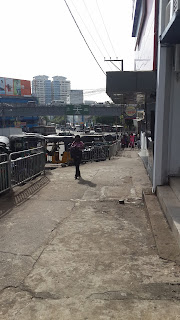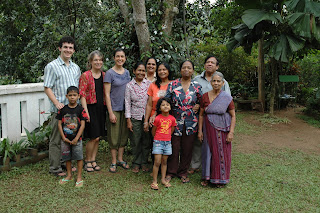The two weeks spent in Sri Lanka traveling with my family were unbelievably different from my previous four months there. We were traveling on the same windy roads, so it still took a long time to get anywhere, and, like before, it was impossible to know what to expect when we arrived at a new place, but it was amazing for me to realize how much easier it is to be a tourist than to live there. However, this may also have something to do with the fact that I could rely on other people (i.e. my parents) to make all the plans.
We started our vacation at the beach in Tangalle (disappointingly not as nice as the beaches I had been to in Hikkaduwa and Unawatuna), then made our way up into the hill country. Not realizing what we were getting in to, we took a slight detour up an incredibly narrow, winding road to a tiny guesthouse next to Bambarakanda Falls, the tallest waterfall in Sri Lanka, where, despite the rainy weather, we went hiking. I remembered the lesson from Hantana and wore close-toed shoes, but still the leeches managed to find their way onto my ankles and legs.
Tangalle
Bambarakanda Falls
Saying good bye to my family in Nuwara Eliya
After a couple days in the small village of Ella, we visited the family I stayed with in Nuwara Eliya and then made our way to Kandy. We saw some Kandyan dance shows, visited the Maligava (Temple of the Tooth), and walked up the hill to the large Buddha statue overlooking the city. What is more memorable than this sight-seeing, however, was Christmas Eve dinner at the Queen’s Hotel, complete with food ranging from rice and curry to sushi to roast turkey to a “U. log” for dessert, a dancing Santa Clause who handed out candy bars, a live band playing a 20 minute version of Jingle Bells, and center pieces that burst into flame at various points throughout the evening. It was a Christmas like no other.
For me, the most meaningful part of the visit to Kandy was saying good-bye to the people I had met there. I visited the ISLE Center, one of my professors, and finally my host family. As I’ve said before, nothing is easy in Sri Lanka, but these farewells, particularly to my host family, were some of the hardest parts of the semester, and were definitely the saddest.
Here I am with some (not all) of my host family and American family
After leaving Kandy, we went up to the Cultural Triangle to see the ruins at Sigiriya, Polonnaruwa, and Dambulla. We also spent a day at the Beach in Trincomalee (much less developed than the beaches in the south) and saw several herds of elephants by the side of the road—an incredible sight!
Wild elephants!
I got home a few days ago and am already Sri Lanka sick and miss my host family (parents, aunts, uncles, cousins, neighbors, and everyone else) a lot. In the end, they really felt like my family. In Sinhala, there is no word for “good-bye.” Instead people say, “Gihin ennan,” which means, “I will go and come,” implying that the good-bye is not forever. My time in Sri Lanka is over for now, but I hope that someday I will be able to go back and visit. Gihin ennan.











































